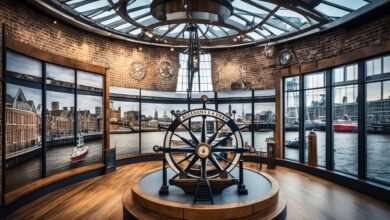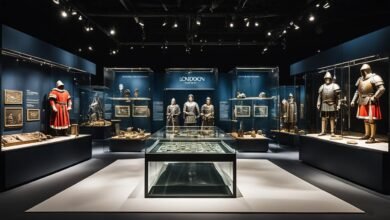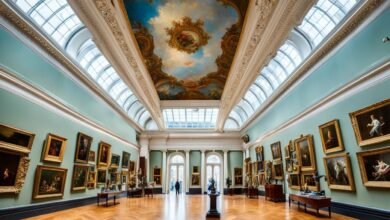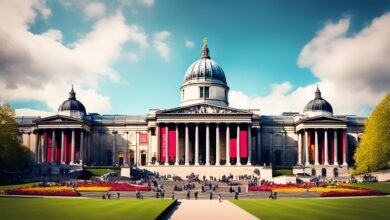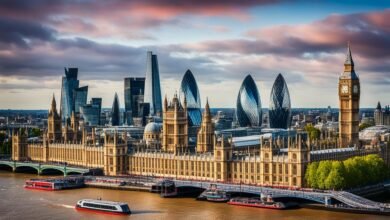The History of the Houses of Parliament
The Houses of Parliament stand as a key symbol of British rule. Known as the Palace of Westminster, it’s where the House of Commons and the House of Lords meet. This place is famous for its striking architecture, like the iconic Elizabeth Tower, which houses Big Ben. It’s a top spot to visit in London, offering a peek into the UK’s political past. Found near landmarks like Westminster Abbey, it’s a major cultural and historical spot.
Did you know there’s much more to it than its grand exterior suggests? This historic building is filled with stories of politics, debates, and architectural marvels. We’ll show you the hidden stories within the Palace of Westminster’s walls. You’ll get to know its legendary rooms, stunning designs, and the political activities that shape the country.
Are you set to uncover the secrets of the Palace of Westminster? Join us on a virtual journey into the heart of one of London’s most important buildings.
A Quick Rundown about the Palace of Westminster
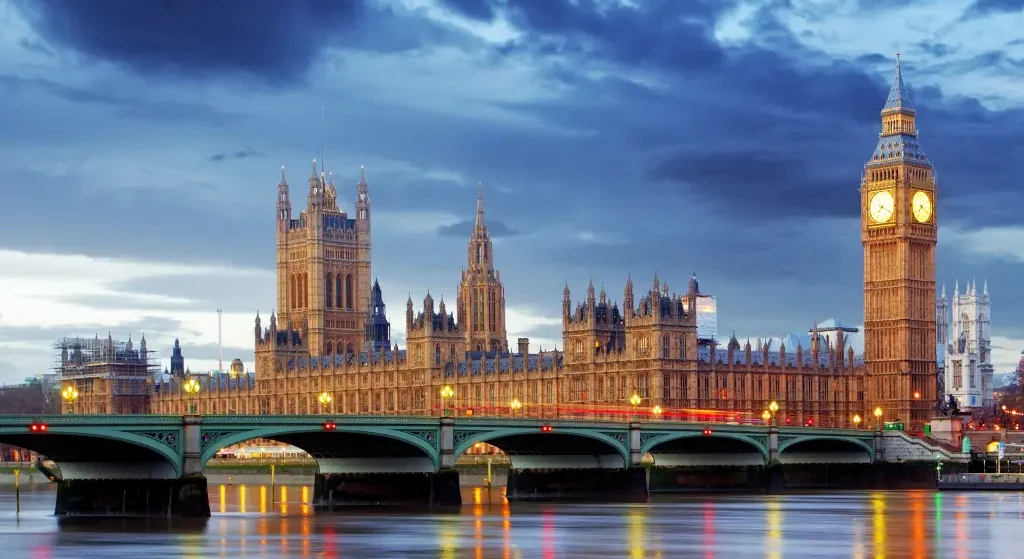
The Palace of Westminster is known as the Houses of Parliament. It’s a key historical site and the heart of the UK’s government. Here, you’ll find the House of Commons and the House of Lords. The palace is central to Britain’s political history and governance.
It draws visitors worldwide who come to see its architecture and understand its role in British politics. The Palace of Westminster sits by the River Thames in London. It’s famous for its Gothic Revival architecture. The Elizabeth Tower and Big Ben make its skyline iconic. This palace symbolizes British democracy and its political history.
The Palace of Westminster has seen many political debates, speeches, and laws being passed. Events from the signing of the Magna Carta in 1215 to recent Brexit debates happened here, marking its importance in British democracy.
Every year, thousands of tourists visit the Palace of Westminster. They come to admire its outside and inside, filled with historical items, artwork, and architectural wonders. Guided tours are available to explain how the UK government works, the monarchy’s role, and parliamentary procedures.
It also provides stunning views of Westminster Abbey and the London Eye. Its location in London’s political center makes it especially attractive. It’s surrounded by significant government and historical buildings.
Architecture
The architecture of the Palace of Westminster is detailed and grand. Charles Barry and Augustus Welby Pugin designed it, combining classical and Gothic elements. Barry provided classical knowledge, while Pugin added Gothic style, defining its look.
The Palace’s mix of Gothic and classical styles shows the UK’s rich history and traditions. Its corridors, halls, and chambers radiate power and authority.
Westminster Hall, the oldest part, dates back to medieval times. The Central Lobby and Norman Porch tell tales of political history. The Royal Gallery has past monarchs’ portraits, while St. Stephen’s Hall showcases stunning art.
The Legislative Process
At the Palace of Westminster, UK politics unfold. It’s where laws are made, discussed, and where national decisions are taken. This is the heart of British lawmaking.
Here, democracy is lively, with debates and compromises. The House of Commons is known for passionate debates on its green benches. The House of Lords offers careful review of legislation.
The palace has many rooms and spaces for government work. Here, lawmakers and the public engage, shaping the nation’s future. It’s where governance’s complexities are addressed and decisions are made.
Palace of Westminster Architecture
The Palace of Westminster stands out for its stunning Victorian architecture. A big fire in 1834 led to its rebuild in a stylish, majestic Gothic look.
Architect Charles Barry and Augustus Welby Pugin worked together on this masterpiece. Barry’s classical style mixed with Pugin’s Gothic flair made a perfect match. This mix shaped the palace’s unique look.
“The architecture of the Palace of Westminster is truly iconic. It stands as a testament to the vision of Charles Barry and Augustus Welby Pugin, capturing the essence of Gothic design and leaving a lasting impression on the world of architecture.”
Rebuilding the palace took nearly 30 years. Every corner shows careful attention to detail. The palace features elaborate towers and intricate designs that dazzle onlookers.
Inside, the palace is just as impressive. It houses grand halls and luxurious chambers. These spaces take you back to a time of elegance and political power.
Experience the grandeur and architectural beauty of the Palace of Westminster for yourself. Visit this historic landmark and immerse yourself in the rich history and iconic design that has captivated visitors for centuries.
Westminster Hall
Westminster Hall is the oldest building in Parliament and has huge historical importance. It was built as far back as 1097, showing the long history of British governance. The building’s age and its architecture awe those who visit.
The hall’s most stunning feature is its hammer-beam roof, made in 1393. This roof shows the amazing skills and engineering of the time. Over time, it has been restored, but it remains a key piece in Gothic design.
“Westminster Hall is a testament to both the historical and architectural grandeur of the Palace of Westminster. Its hammer-beam roof is an awe-inspiring sight that speaks to the craftsmanship of the past.”
Discover the Enchanting Sorolla Museum in Madrid
Westminster Hall has had many uses over the years. It has been the site of coronation banquets, big trials, and important historical events. Walking through, one feels connected to the deep history of Britain.
Visiting the Palace of Westminster, don’t miss Westminster Hall. Marvel at its roof and feel the history of British governance. It is a key piece of Britain’s heritage and a must-visit for those interested in the nation’s past.
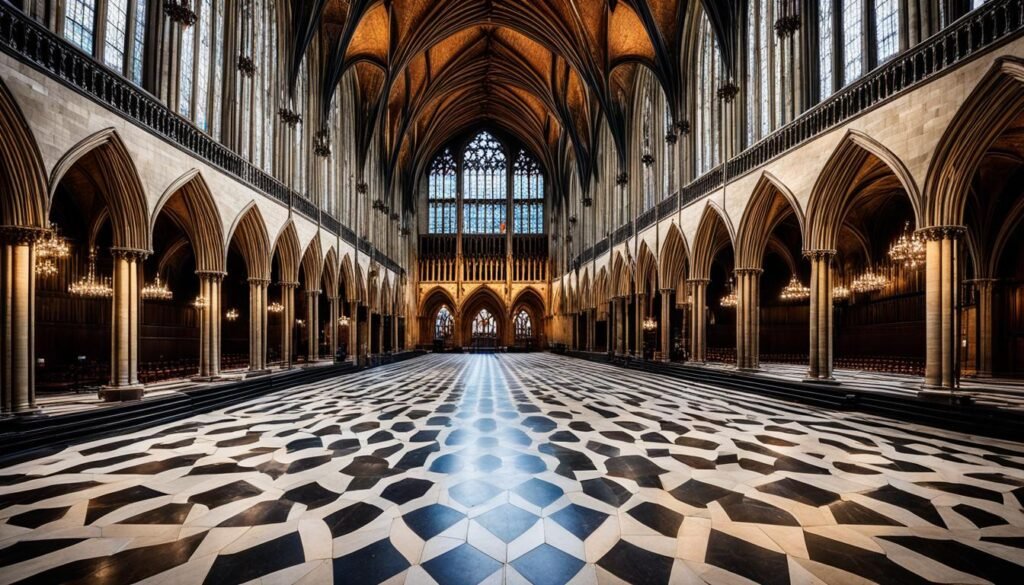
The Oldest Building in Parliament
Westminster Hall, dating back to 1097, is Parliament’s oldest building. It shows the extensive history of British governance.
Awe-Inspiring Hammer-Beam Roof
The majestic hammer-beam roof in Westminster Hall captivates all. Made in 1393, it showcases the era’s craftsmanship and Gothic design.
Historical Significance and Grandeur
Westminster Hall has seen key historical moments, from banquets to trials. Its grandeur and significance make it a notable place in the Palace of Westminster.
St. Stephen’s Hall
St. Stephen’s Hall is a key part of the Palace of Westminster. It sits at the heart of the House of Commons. It acts as the gateway for members of Parliament and the public into British democracy.
When you enter, art and sculptures will grab your attention. These pieces are from the old St. Stephen’s Chapel, lost in the 1834 fire. Now, they highlight the long history and culture of the British Parliament.
In the hall, art tells the House of Commons’ story. Portraits and sculptures show important figures and moments in politics. Each artwork shines a light on those who have shaped political history. It’s a tribute to how the House of Commons honors its past.
St. Stephen’s Hall lets the public see Parliament in action. Waiting to enter the House of Commons, you’ll feel the excitement. Here, you join others to watch the nation’s future being debated.
This hall is about openness, history, and culture in the House of Commons. It’s where art, politics, and history meet. You’re invited to explore and appreciate the role of the House of Commons in the UK’s democracy.
Highlights of St. Stephen’s Hall:
- Exquisite art and sculptures recovered from St. Stephen’s Chapel
- A visual feast showcasing the history and heritage of the House of Commons
- An entrance to the House of Commons, where you can observe debates and discussions
- A symbol of transparency and accessibility in British democracy
Central Lobby
The Central Lobby is at the heart of the Palace of Westminster. It links the House of Commons and the House of Lords. Here, lawmakers meet and make important decisions.
The Central Lobby is stunning, known for its intricate tiled floor. This floor has seen many visitors over the years. As you walk, the craftsmanship demands your admiration.
Look up to see the high windows and arches. They are lined with statues of royal figures. These statues remind us of the monarchy’s lasting influence.
The Central Lobby isn’t just about its impressive architecture. It’s a busy place where politics and public life meet. People come here to talk to their MPs and push for change.
“The Central Lobby is more than just a physical space; it is a symbol of our democracy. It is where the voices of the people converge, where ideas clash and merge, and where the heartbeat of our nation is felt.”
There’s a unique energy in the Central Lobby. It’s a testament to the power of democracy and dialogue. This place shows how ideas lead to progress.
Whether you’re watching lawmakers, joining in conversations, or admiring the beauty, the Central Lobby offers an unforgettable experience. It brings you into the heart of the Palace of Westminster.
Norman Porch
The Norman Porch is a special doorway at the Palace of Westminster. It’s where the Sovereign enters for the State Opening of Parliament. This takes place at the Victoria Tower’s base. It’s a historical site with deep meaning, signaling the start of an important event.
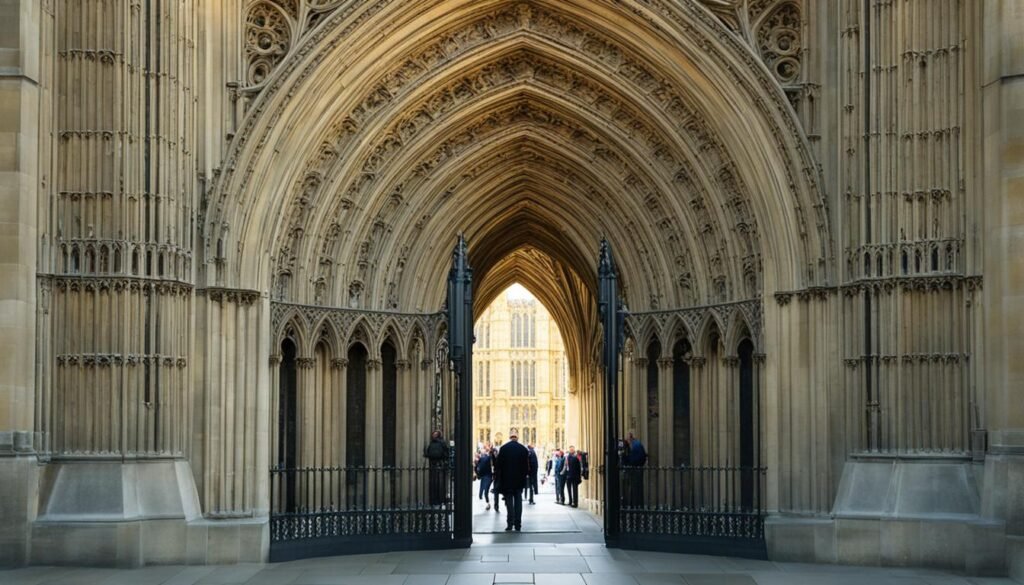
Every year, the State Opening of Parliament is a grand tradition. At this event, the Queen sits in the House of Lords. She speaks to the Members of Parliament about future laws. To get there, she walks up the Royal Staircase to the Norman Porch. This path makes the event even more impressive.
The Norman Porch shows the Palace of Westminster’s role in UK governance. Its design and royal presence make the event unforgettable. It shows how the monarchy and government are connected. Plus, it highlights British traditions in politics.
Robing Room
The Robing Room is also called the Queen Chambers. It’s a special part of the Palace of Westminster. Only the Head of State uses it during the State Opening of Parliament. This room is where the Queen prepares for her procession to the House of Lords. It’s an important national event.
Inside the Palace, the Robing Room provides a calm and royal setting. The Head of State gets dressed in ceremonial clothes here. The room shows the importance of the State Opening of Parliament. It blends history, tradition, and today’s government, showing the British monarchy’s lasting power.
 Visit Madrid’s Museo Thyssen-Bornemisza Art Gems
Visit Madrid’s Museo Thyssen-Bornemisza Art Gems
Entering the Robing Room brings a feeling of excitement. The room is filled with beautiful tapestries and fancy furniture. It shows the greatness of the State Opening of Parliament. The Queen’s robes, full of symbols and tradition, are ready for her.
The journey to the House of Lords goes through the Royal Gallery. This corridor is decorated with impressive portraits. They show the rich history of the British monarchy. Then, the procession reaches the Prince’s Chamber. This area honors Queen Victoria and other historical figures.
Everything in the Robing Room is perfectly prepared. It ensures the Head of State is ready for an important event in the British political year. The Queen makes her final outfit adjustments here. This space helps start the State Opening of Parliament smoothly.
The Robing Room showcases the British monarchy’s splendor and history. It’s where the Head of State gets ready to represent the country’s unity. The room links the past to today. It sets the scene for the State Opening of Parliament, a sign of the United Kingdom’s enduring strength.
Royal Gallery
The Royal Gallery sits grandly inside the Palace of Westminster. It’s known for its majestic beauty. This gallery is used for important ceremonies like the State Opening of Parliament. The Head of State walks through, with music and a group, showing off its elegant halls. It’s also where big events like state dinners happen, making it a special place.
When you walk into the Royal Gallery, you see many portraits. These show the faces of past kings and queens who have led Britain. These paintings take you on a visual trip through history. They show how the monarchy has changed over time. From Queen Elizabeth I to King George III, each portrait has a story of power and ruling.
In the gallery, there are two amazing fresco paintings. An artist named Daniel Maclise, from Ireland, made them in the Victorian era. These frescoes tell stories from British history. Looking at them, you feel like you’re stepping back in time. It’s like being surrounded by history.
The Royal Gallery shows the glory of the Palace of Westminster. With its stunning portraits and frescoes, it celebrates the Victoria and Albert era’s art. It also reminds us how important the monarchy has been to Britain’s history.
Prince’s Chamber
The Prince’s Chamber is important in the Palace of Westminster. It is used by Members of Parliament for meetings and talks. It has a direct link to the House of Lords, making work between the two houses easy.
A statue of Queen Victoria by John Gibson stands out here. This beautiful statue honors the queen’s strong influence on British history.
Richard Burchett’s art adds beauty to the room. His portraits show Tudor monarchs, sharing glimpses of the past.
Over these portraits, art about the Spanish Armada can be seen. They remember the tapestries lost in 1834’s fire. This art celebrates the Spanish Armada’s historic importance and the room’s artistic flair.
Famous Statue of Queen Victoria
The Prince’s Chamber is a mix of art, history, and politics. It shows the diverse aspects of the Palace of Westminster.
| Features of the Prince’s Chamber | Description |
|---|---|
| Queen Victoria Statue | A statue of Queen Victoria, crafted by artist John Gibson, stands as a focal point within the chamber. |
| Richard Burchett Paintings | The room is adorned with portraits of monarchs from the Tudor Royal Family, painted by artist Richard Burchett. |
| Spanish Armada Tribute | A series of paintings depicting the Spanish Armada are displayed, paying tribute to the lost tapestries. |
House of Lords Chamber
The House of Lords Chamber is a key spot in the Palace of Westminster. It’s where laws and decisions are made by the British government. This chamber brings together the Sovereign, the Commons, and the Lords.
The chamber’s design is stunning, with a Gothic style. It has grand arches and high ceilings. These features show the beauty of Gothic design in the Palace of Westminster.
At the heart of the chamber is a gold-gilded wooden canopy. It marks the power seat during the State Opening of Parliament. The Sovereign uses this throne to speak to the Members of Parliament.
“The House of Lords Chamber stands as a symbol of authority and tradition, steeped in centuries of British history.” – Famous Historian
Near the throne is the Woolsack where the Lord Speaker sits. This special seat highlights the Lord Speaker’s role. It shows they guide discussions without taking sides.
The House of Lords has a rich red color, unlike the green in the House of Commons. This red echoes the noble status of the Lords in making laws.
The House of Lords Chamber has a long history and a Gothic design. It’s important for ceremonies and government. This place is where British laws are shaped and the nation’s future is decided.
Key Features of the House of Lords Chamber:
| Feature | Description |
|---|---|
| Gothic Design | The House of Lords Chamber showcases captivating Gothic architecture, reflecting the historical style prevalent in the Palace of Westminster. |
| Woolsack | The Woolsack, positioned between the throne and the benches, represents the Lord Speaker and provides a distinct seating arrangement. |
| Legislative Process | The House of Lords Chamber serves as a venue where legislation is debated, amended, and ultimately passed or rejected. |
The Moses Room and Member’s Lobby of the House of Commons
The Moses Room and Member’s Lobby are key areas in the House of Commons. They are located in the historic Palace of Westminster. These places are vital for the political processes and debates that decide the nation’s future.
The Moses Room is used by the Grand Committees and is very important. Here, members meet, share ideas, and make decisions. It shows the democratic values and talks that happen in the House of Commons.
The Member’s Lobby is next to the main chambers and is full of life. It’s where Members of Parliament get ready for debates. They meet here to plan, share views, and discuss important issues.
This lobby has letter boards and message boxes to help MPs know what’s coming up. It’s a key spot for sharing news and working together.
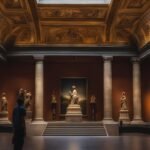 Explore History at National Archaeological Museum Madrid
Explore History at National Archaeological Museum Madrid
The Moses Room and Member’s Lobby show the energy and talk that define the House of Commons. They highlight the hard work of Members of Parliament. They are dedicated to making decisions that affect many lives. In the Palace of Westminster, these places symbolize democracy and the power of talk.
